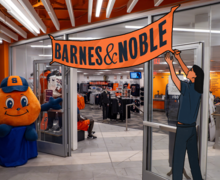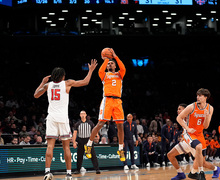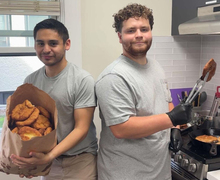The great divide: Student partiers, East neighborhood residents struggle to mix beyond Westcott
The end of any territorial war calls for borders to be erased and redrawn. In Syracuse’s East neighborhood, the struggle for land between local residents and students pushes on.
Dividing the aggressors is a line of demarcation: Westcott Street. And the views of students and permanent residents over who belongs where can clash.
Kendall Phillips, an associate dean in the College of Visual and Performing Arts, has lived on Fellows Avenue, three blocks east of Westcott, for 11 years. According to him, some students from the West have simply gone too far.
During his time in the area, Phillips has discovered that Westcott Street is the East neighborhood’s defining boundary between where Syracuse University students can party and where they cannot.
‘Between the university and Westcott, that corridor of Lancaster and Ackerman and such is a sort of demilitarized zone where, for some reason, people are willing to tolerate the drunken parties ‘til two in the morning,’ Phillips said.
Phillips’ demilitarized zone contains blocks known for students with late-night drinking habits, though local residents are scattered among them. Students can have their fun between Comstock Avenue and Westcott Street. Beyond that, the community and local law enforcement simply won’t tolerate it, Phillips said.
‘I think sometimes periodically students will move to one of those houses out beyond Westcott and be surprised that not only does everybody call the cops, but they actually show up and tell them they need to shut it down,’ Phillips said. ‘They didn’t get the message that Westcott is the boundary.’
But for some students, they may not have any other choice but to move east of Westcott, said Darya Rotblat, director of off-campus and commuter services.
‘Students are going to take whatever property available, we have a shortage of housing,’ Rotblat said. ‘If there’s a house available that is somewhat close to a bus stop, those are viable properties.’
Saying all students are unwelcome is an overstatement, but the culture frequently associated with the expression of college freedoms is not, Phillips said.
‘What I find interesting about university students in general is that there seems to be an almost religious belief that, ‘I’m in college, this is my time to be irresponsible’ — almost like it’s an obligation,’ Phillips said. ‘It’s like a religion. It’s the religion of the party.’
Not all find the tenants of this religion entirely believable.
Olivia Rhinehart, a junior English education major, grew up in Manlius, N.Y. Having lived in a suburb all her life, she was eager for the chance to live some place that challenged her comfort zone.
‘It’s not a safe choice, in the idea that you are removing yourself from people you know,’ Rhinehart said. ‘But living on the other side of Westcott has opened my eyes to people I never would have met.’
Rhinehart and her undergraduate roommates have lived on Victoria Place, east of the Westcott lines, since July. One of the biggest issues with the line, she said, is the lack of understanding about the Westcott Nation, the residents on and around Westcott Street.
‘I like the fact that families are around, I don’t know if they don’t like that I’m there,’ Rhinehart said. ‘I like the community aspect, and for the most part I don’t think we’ve really imposed.’
Rhinehart said parties at her house tend to be more intimate because freshmen and random guests rarely travel that far, a benefit of living past Westcott. She also said she doesn’t worry about things being stolen every time she has a party.
With two children enrolled at SU, Rhinehart’s father attempted to buy a house, unsuccessfully, thinking it would be cheaper in the long run. Rhinehart said generalizations toward the intentions of college students made her father unable to purchase the house.
‘They see the youth, and maybe they remember their own youth or have had a problem in the past, but you can’t say that about everyone,’ Rhinehart said. ‘That’s not the culture of the youth at all. I think that’s an overstatement — you don’t always have to be wild and crazy.’
Barbara Humphrey has lived in the Westcott neighborhood for 20 years and is the president of the Westcott East Neighborhood Association. She has seen the struggle between the two sides ebb and flow.
In the mid-1990s, when enrollment dropped, students were able to move closer to the university, allowing local residents to take ownership of the Westcott East neighborhood, she said. Humphrey said the increase in drinking age in the 1980s is when the relationship between residents and students went downhill, when normal student-rented houses converted into makeshift bars.
‘Students are going to drink,’ Humphrey said. ‘I don’t care whether its 1880, 1980 or 2010. I think the drinking age (increase) turned our neighborhood into house parties, which I don’t think there were that many before.’
Underage drinking became a concern for local residents, increasing tensions between students and locals, Humphrey said. But accepting the close quarters among residences on each side of Westcott is part of what living in a city is all about, she said.
‘I get annoyed at permanent residents who complain about noise that I think is part of living in a city,’ Humphrey said. ‘When I’ve known people very angry, loud and anti-student, part of my attitude was that they’re living in the wrong place.’
Rhinehart, the student living past Westcott, said people get what they pay for when living in a college town and should weigh the pros and cons.
The idea that living in a college town requires local residents to give students leeway on any community disturbances makes no sense, Phillips said. While the occasional broken beer bottle doesn’t bother him, he said larger issues do.
‘The idea that not only you have a party and there’s glass all over the sidewalk, then the person in the house thinks that they don’t have to worry about that — that seems like remarkably uncivil behavior,’ Phillips said. ‘You’d think that, especially with smart, university well-educated young people learning to become productive American citizens, you would want to learn a level of civil responsibility.’
Students who intend to live east of Westcott may also want to consider what they are getting themselves into, Humphrey said. Ending the West-East battle requires both sides to have realistic expectations.
‘If I was a student and there was a lesser concentration of students, such as on Roosevelt or Fellows avenues, there’d be more people to complain, as opposed to a (street like) Ackerman, where both sides and across the street were students,’ Humphrey said. ‘It’s sort of about taking the path of least resistance.’
Rotblat said in her five years at the Office of Off-Campus and Commuter Services, there has not been a significant change in the number of complaints east of the Westcott border. But the focus should be more about creating a positive relationship rather than strictly the number of calls to local police, she said.
‘We want to educate students to be good community members later on, and permanent residents want a nice place to live,’ Rotblat said. ‘So it’s about how you make the partnership work, and right now it is not a well-oiled machine by any means.’
Published on November 30, 2010 at 12:00 pm





